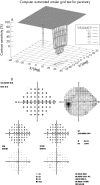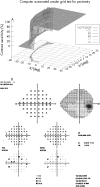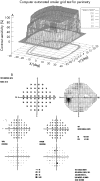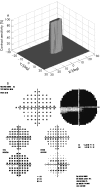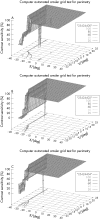Early detection of glaucoma by means of a novel 3D computer-automated visual field test
- PMID: 17504855
- PMCID: PMC2001017
- DOI: 10.1136/bjo.2007.116103
Early detection of glaucoma by means of a novel 3D computer-automated visual field test
Abstract
Purpose: A recently devised 3D computer-automated threshold Amsler grid test was used to identify early and distinctive defects in people with suspected glaucoma. Further, the location, shape and depth of these field defects were characterised. Finally, the visual fields were compared with those obtained by standard automated perimetry.
Patients and methods: Glaucoma suspects were defined as those having elevated intraocular pressure (>21 mm Hg) or cup-to-disc ratio of >0.5. 33 patients and 66 eyes with risk factors for glaucoma were examined. 15 patients and 23 eyes with no risk factors were tested as controls. The recently developed 3D computer-automated threshold Amsler grid test was used. The test exhibits a grid on a computer screen at a preselected greyscale and angular resolution, and allows patients to trace those areas on the grid that are missing in their visual field using a touch screen. The 5-minute test required that the patients repeatedly outline scotomas on a touch screen with varied displays of contrast while maintaining their gaze on a central fixation marker. A 3D depiction of the visual field defects was then obtained that was further characterised by the location, shape and depth of the scotomas. The exam was repeated three times per eye. The results were compared to Humphrey visual field tests (ie, achromatic standard or SITA standard 30-2 or 24-2).
Results: In this pilot study 79% of the eyes tested in the glaucoma-suspect group repeatedly demonstrated visual field loss with the 3D perimetry. The 3D depictions of visual field loss associated with these risk factors were all characteristic of or compatible with glaucoma. 71% of the eyes demonstrated arcuate defects or a nasal step. Constricted visual fields were shown in 29% of the eyes. No visual field changes were detected in the control group.
Conclusions: The 3D computer-automated threshold Amsler grid test may demonstrate visual field abnormalities characteristic of glaucoma in glaucoma suspects with normal achromatic Humphrey visual field testing. This test may be used as a screening tool for the early detection of glaucoma.
Conflict of interest statement
Competing interests: WF and AAS may have proprietary interest as patents on the test technology used in this study are issued. PPN, BF and DM have no proprietary interest.
Similar articles
-
Novel 3D computer-automated threshold Amsler grid visual field testing of scotomas in patients with glaucoma.Eur J Ophthalmol. 2009 Sep-Oct;19(5):776-82. doi: 10.1177/112067210901900515. Eur J Ophthalmol. 2009. PMID: 19787597
-
Three-dimensional computer-automated threshold Amsler grid test.J Biomed Opt. 2004 Jan-Feb;9(1):149-53. doi: 10.1117/1.1625952. J Biomed Opt. 2004. PMID: 14715067
-
Peristat: a computer-based perimetry self-test for cost-effective population screening of glaucoma.Curr Eye Res. 2005 Jan;30(1):1-6. doi: 10.1080/02713680490522399. Curr Eye Res. 2005. PMID: 15875358
-
Entoptic perimetry screening for central diabetic scotomas and macular edema.Ophthalmology. 2000 Apr;107(4):755-9. doi: 10.1016/s0161-6420(99)00149-9. Ophthalmology. 2000. PMID: 10768339 Clinical Trial.
-
Visual field testing in glaucoma using the Swedish Interactive Thresholding Algorithm (SITA).Surv Ophthalmol. 2025 Jan-Feb;70(1):141-152. doi: 10.1016/j.survophthal.2024.09.005. Epub 2024 Sep 29. Surv Ophthalmol. 2025. PMID: 39349186 Review.
Cited by
-
Visual Field Sensitivity Prediction Using Optical Coherence Tomography Analysis in Hydroxychloroquine Toxicity.Invest Ophthalmol Vis Sci. 2022 Jan 3;63(1):15. doi: 10.1167/iovs.63.1.15. Invest Ophthalmol Vis Sci. 2022. PMID: 35015028 Free PMC article.
-
Quantitative analysis of central visual field defects in macular edema using three-dimensional computer-automated threshold Amsler grid testing.Graefes Arch Clin Exp Ophthalmol. 2009 Feb;247(2):165-70. doi: 10.1007/s00417-008-0971-8. Epub 2008 Oct 29. Graefes Arch Clin Exp Ophthalmol. 2009. PMID: 18958487 Clinical Trial.
-
Amsler Grid Versus 10-2 Test in Primary Open Angle Glaucoma.J West Afr Coll Surg. 2023 Apr-Jun;13(2):92-99. doi: 10.4103/jwas.jwas_275_22. Epub 2023 Mar 20. J West Afr Coll Surg. 2023. PMID: 37228887 Free PMC article.
-
Paradigm Shifts in Ophthalmic Diagnostics.Trans Am Ophthalmol Soc. 2016 Aug;114:WP1. Trans Am Ophthalmol Soc. 2016. PMID: 28008209 Free PMC article. Review.
-
Amsler grid test for detection of advanced glaucoma in Ethiopia.PLoS One. 2020 Mar 10;15(3):e0230017. doi: 10.1371/journal.pone.0230017. eCollection 2020. PLoS One. 2020. PMID: 32155202 Free PMC article.
References
-
- Quigley H A, Addicks E M, Green R. Optic nerve damage in human glaucoma. III. Quantitative correlation of nerve fiber loss and visual field defect in glaucoma, ischemic neuropathy, papilledema, and toxic neuropathy. Arch Ophthalmol 1982146135–146. - PubMed
-
- Sponsel W E. Tonometry in question: can visual screening tests play a more decisive role in glaucoma diagnosis and management? Surv Ophthalmol 198933291–300. - PubMed
MeSH terms
LinkOut - more resources
Full Text Sources
Other Literature Sources
Medical


